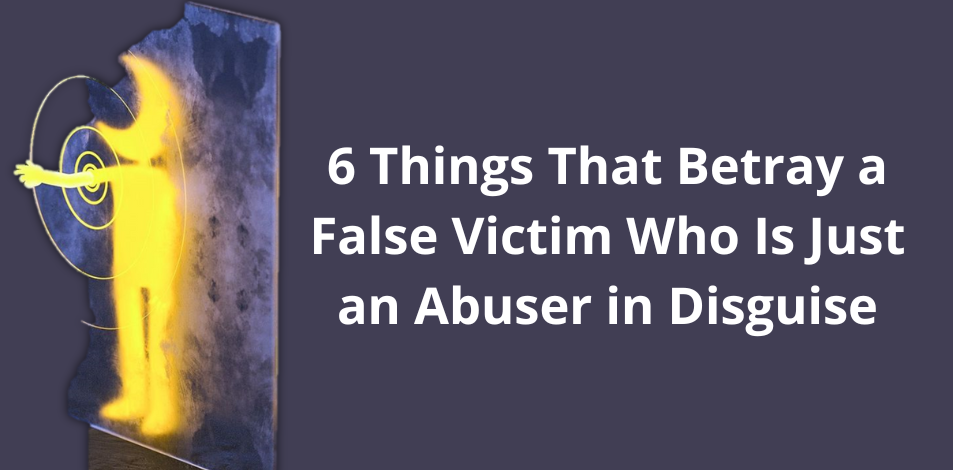
As if life wasn’t confusing enough, we must now distinguish between the false victim and the actual target. This is not a simple job and requires a lot of life experience and education.
Trauma happens to thousands of people. And with so many unfortunate event victims, the false victim can emerge, pretending to be an abuse survivor.
A false victim is a person who preys on real victims to gain attention, or for other selfish gain. So, how can we distinguish who is struggling and who is using parasitic traits to get ahead?
Differences between a false victim and a real victim
Learning to separate the real victim from the fake one can be difficult. In reality, the false victim is actually a type of abuser who pretends to be abused. It is convoluted and can be important to understand. This, of course, is part of the false victim’s intent.
The more confused you are, the more likely you are to think that you are the problem. So, let’s take a look at some of the ways we can separate the false victim from the real one.
- Adverse feedback
If you see someone screaming out of anger, you would assume that they are being abused. But wait. Yes, verbal abuse is a thing, we all know that.
False victims, however, can stir up anger in others after long periods of covert abuse. Let’s just say that if you pet a bear over and over again, it might get angry. And then, you’ll say, “Look how vicious that animal is. It’s frenzied!” But what made it that way?
See the picture? False victims have mastered the art of causing negative reactions in others in an attempt to make them appear the victim of verbal abuse. They say things that seem harmless, but all of these things are meant to upset their purpose.
Fake victims know that the target’s reaction will probably be explosive, making the real aggressor look like a victim. I hope this isn’t too convoluted to understand.
- Strong victim mentality
The real victim will tell you his story, and he might tell you more than once. However, true survivors will not use their trauma for selfish gain.
False victims talk about being wronged by someone all the time. In every argument or fight, they will always claim innocence. They are the victim forever.
With this victim mentality, they will not take responsibility for their own mistakes. There will always be someone else who has caused any problems they have. Just pay attention to one specific thing: Are they to blame for past relationship problems? If not, you have found yourself a false victim.
- Self-esteem issues
Actual victims struggle with self-doubt, no matter how confident they try to be. It is just a seed of negativity sown by manipulation in the past. No matter how much trauma they have experienced, the real victims wonder if they caused the pain and suffering they experienced.
Pseudo-victims, on the other hand, wear a mask of confidence, appearing to be confident in themselves and in being a victim. They are quick to blame their “offenders” and slow to look inward.
False victims point to others as the sole cause of the negative things they do. They don’t suspect what they’re doing, even when they know they’re hurting others.
- The ability to show empathy
Abusers learn manipulative tricks to appear more sympathetic. Actual victims retain the basic capacity for empathy.
While the lines between victim and abuser are blurred due to recent social movements, empathy is the only trait that real victims retain through various ordeals. While some victims become callous and empathy diminishes, there is always some kindness buried deep within.
If you meet an angry person with diminished kindness, look closer. This may be a real victim of abuse.
- Validation
Violators posing as victims will validate everything they do wrong. When it comes to outbursts of anger, cheating, or theft, the false victim will claim that her wrongdoings were due to someone else’s actions and, therefore, that it was true. And they usually don’t feel bad about their actions.
False victims may get a good night’s sleep after doing something very wrong, while real victims tend to stay restless trying to understand how to be a better person.
Survivors of trauma or abuse do not validate their negative actions because they know they are ultimately at fault for what they are doing. If you pay attention, you can see this check separating the fake victim from the real one.
- Positive intent versus malevolent intent
Actual victims may see kindness as mere kindness. But the lying victims may be perpetually paranoid. Kindness may be seen by plaintiffs as malicious intent.
What I mean is that when the real victim does something nice for the abuser, it may be seen as a hoax. Abusers are so used to being manipulated that they think everyone else is being manipulated too. Be wary of someone who always thinks you are trying to deceive them.
Can you separate the false victim from the real victim?
It wouldn’t be easy to separate the real from the fictional in this case, not by a long shot. Victims become abusers and can become victims again, and so on and so forth.
Yes, I said what I said. The cycle of abuse may continue until someone says “Enough is enough,” and that will take a toll.
The ability to distinguish between those who are being harmed and those who are harming requires close observation. Over time, you can tell the difference and possibly learn more about victimization.
Not only can this protect you, but it can also make you a better person. Because honestly, we can all be victims or abusers. Therefore, we must always strive to be the best we can be for ourselves and others.




